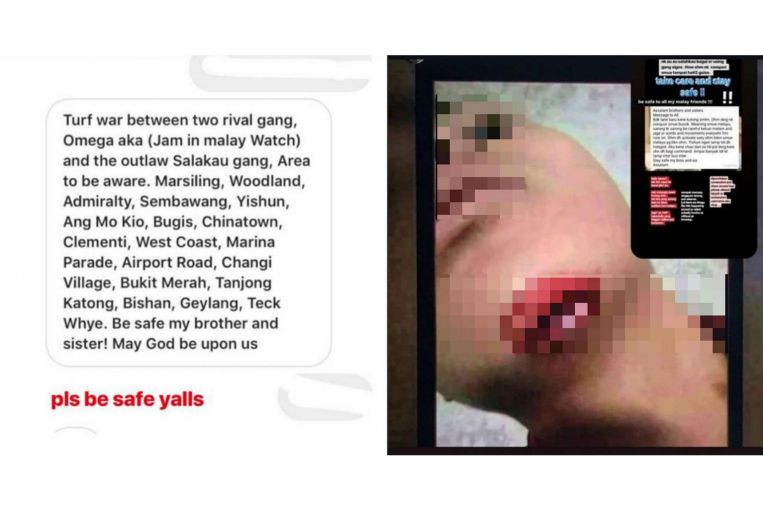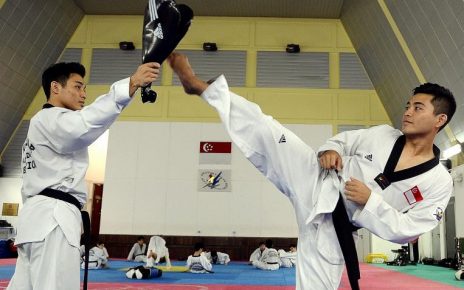
From claims of terrorist plots in Orchard Road to eyewitness accounts of an attempt to kidnap a child in Jurong Point, social media has made it convenient for rumours to spread widely and quickly.
The latest involves a photo of an unidentified youth with a gaping wound on his chin. The first few messages shared on Instagram and WhatsApp claimed that he was the victim of a gang fight.
However, with each message, another layer of fake news was seemingly added by other users. There were videos shared, purportedly of fights that took place in Singapore as a result of a turf war between two rival gangs.
The police say none of the alleged incidents took place and assured the public that the information spread through the text messages and videos was false. They also advised the public to stop circulating the false information.
In 2016, messages spread on WhatsApp claimed that terrorist attacks were being planned for December, at areas like Orchard Road and VivoCity shopping mall.
It was fake news.
In March 2017, messages spread on social media claiming that two children were kidnapped at Jurong Point shopping mall. Again, it never happened.
The latest rumours in Singapore referred to gangs “Omega” and “Salakau” fighting in various parts of Singapore.
Social media users on Reddit said they had seen the messages circulating on Instagram, which claimed the fights were caused by racial tensions and warned others to stay away from alleged gang members of a particular race.
Several readers alerted citizen journalism website Stomp to messages circulating on Instagram and WhatsApp.
Some of the messages alleged extreme violence in areas such as Yishun and Woodlands, including the death of a boy from Admiralty Secondary School. None of it was true.
The messages eventually reached Facebook user Wan Thurs, who claimed that the photo of the youth was an old picture of his cousin after he met with an accident.
An Instagram user, who wanted to be known only as Mr Khalid, said he first received the messages of gang fights on Aug 23.
The 23-year-old told The Sunday Times: “Having spent a few years on social media, I am able to make out what is real and probable and what is fake. We must all improve our media literacy to tackle these things as a community.”
Professor Ang Peng Hwa from Nanyang Technological University’s Wee Kim Wee School of Communication and Information noted that people who share such messages may not see themselves as contributing to a problem.
“The failure to do basic checks may also reflect their own bias,” he said, adding that this may include greater reliance on social media as a source of news and information.
In Mexico, two innocent men were burned to death before anyone bothered to check if the claim that they had been involved in child abduction cases was true. It was not.
Last year, the media in India reported that 29 people were lynched in a year over rumours of child abductions shared on WhatsApp. It prompted the platform, which is owned by Facebook, to launch its first TV campaign in India last year to address the spread of misinformation.
Some of the rumours may conceal a sinister plot within the layers of lies.
In 2016, fake news spread quickly in Germany of a 13-year-old girl of Russian origin who had been raped in Berlin by refugees from the Middle East. However, it turned out to be fake news, which experts traced to an orchestrated move from within Russia to undermine Berlin’s refugee policy in the wake of the Syrian civil war.
Prof Ang, who is also chairman of the Advertising Standards Authority of Singapore, said: “Such rumours can be organised by people who have the resources and know the buttons to press. But once the authorities debunk the rumours, and people know they are being used, they won’t like it. In the long run, it won’t work.”
In Singapore, the Government passed the Protection from Online Falsehoods and Manipulation Bill. The new law is designed to give the Government the tools to deal with falsehoods on the Internet that can go viral in a matter of minutes and cause untold harm.
The police can also charge a suspect with causing harassment, alarm or distress under the Protection from Harassment Act.
•Additional reporting by Malavika Menon
•Not sure if something is fake news? Readers can send an e-mail with their questions and a link to the suspect article to askst@sph.com.sg
•Reports published can be found on the ST website under a special “fake news debunked” section at
SEE



